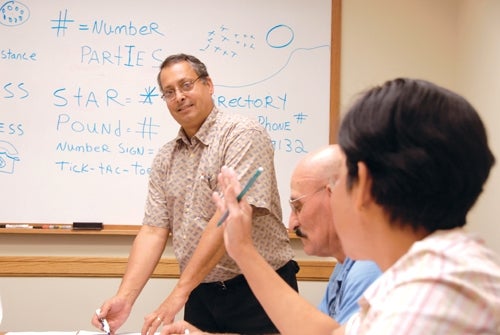A Sturbridge company dealing with a problem manufacturers have faced since the first wave of Industrial Revolution immigrants hit New England’s shores has come up with a way to topple language barriers: Teach employees English on company time.
G&F Industries, a plastics company just off Route 20 in Sturbridge, was finding it difficult to make all of its employees understand their jobs, their safety and their coworkers due to language barriers. According to Mark Berry, the company’s operations manager, about one third of G&F’s 120 employees primarily speak languages other than English, mostly Spanish and Mandarin.
A basic language barrier can be problem enough, but “the nature of the manufacturing business we’re in, it has a lot of its own vocabulary,” Berry said. So getting every employee to learn English was also a workforce development initiative for G&F.
G&F manufactures injection molded plastic components for the auto, medical and consumer electronics industries.
Safety Signals
“What we really want them to do is understand the job, understand safety and understand the workplace documentation,” Berry said. He said when the company decided to make learning English part of the G&F job description, it first approached area community colleges but the schools did not have off-campus services available.
Literacy Volunteers of South Central Massachusetts does and was excited about helping G&F, Berry said. He said Literacy Volunteers had been contacted by other manufacturers facing the same problem, but those companies hadn’t started a program because they didn’t want to use company time for a literacy program.
Those companies may be missing out. According to Berry, the program hasn’t cost G&F a cent. Literacy Volunteers trained G&F managers to conduct the class and now the entire program is conducted in-house.
“You can send people out and they’ll be fine,” Berry said, but G&F wanted a program not just to teach English to employees, but to teach English as it relates to working at G&F. “We want our employees to understand what they’re trying to accomplish,” he said.
In the past, supervisors trying to help non-English speaking employees understand company procedures or documentation got “a lot of head-nodding on the floor, but they really didn’t understand what we were teaching them,” Berry said.
Now, Berry said there’s more interaction on the factory floor between non-English speaking employees. “They’re discussing what they’re doing amongst each other,” he said.
The company’s workplace English program has been mandatory for non-English speaking employees for about two months. Two groups of employees each spend one hour per week in lessons during the work day. Berry said the company hopes to expand the program to two classes per week and one day to have a current student teach the class.
“It’s put a lot of excitement into the people who work here, and it helps us develop the people we have and hopefully keep them here. It’s the ever-changing workforce,” Berry said.
Vanessa Fors, a volunteer coordinator at Literacy Volunteers, said she was impressed with the extent of G&F’s initiative and the support of the program by G&F’s executives. “You don’t see that every day,” she said. She said other companies have approached Literacy Volunteers looking for a tutor for an employee or two, but none have come looking for multiple in-house tutors to be trained by Literacy Volunteers.
“It’s easy to set up when tutors and students have the same job. It’s kind of a natural fit. If you bring in an outside person, you’re going to have to train them on your protocol,” Fors said.

